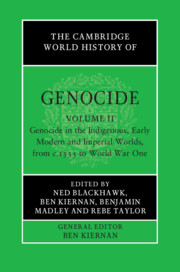Book contents
- The Cambridge World History of Genocide
- The Cambridge World History of Genocide
- The Cambridge World History of Genocide
- Copyright page
- Contents
- Figures
- Maps
- Tables
- Contributors to Volume ii
- Introduction to Volume ii
- Part I Settler Colonialism
- Part II Empire-Building and State Domination
- 4 A Case Lacking Contemporaneous Local Sources
- 5 Atrocity and Genocide in Japan’s Invasion of Korea, 1592–1598
- 6 The English Conquest of Ireland, c.1530–c.1650
- 7 Extirpation and Annihilation in Cromwellian Ireland
- 8 Genocide in the Spice Islands
- 9 ‘Too Furious’
- 10 The Destruction of Wendake (Huronia), 1647–1652
- 11 A ‘Spreading Fire’
- 12 The Qing Extermination of the Zünghars
- 13 A Vicious Civil War in the French Revolution
- 14 The Zulu Kingdom as a Genocidal and Post-genocidal Society, c.1810 to the Present
- Part III Nineteenth-Century Frontier Genocides
- Part IV Premonitions
- Index
11 - A ‘Spreading Fire’
Understanding Genocide in Early Colonial North America, 1607–1790s
from Part II - Empire-Building and State Domination
Published online by Cambridge University Press: 23 June 2023
- The Cambridge World History of Genocide
- The Cambridge World History of Genocide
- The Cambridge World History of Genocide
- Copyright page
- Contents
- Figures
- Maps
- Tables
- Contributors to Volume ii
- Introduction to Volume ii
- Part I Settler Colonialism
- Part II Empire-Building and State Domination
- 4 A Case Lacking Contemporaneous Local Sources
- 5 Atrocity and Genocide in Japan’s Invasion of Korea, 1592–1598
- 6 The English Conquest of Ireland, c.1530–c.1650
- 7 Extirpation and Annihilation in Cromwellian Ireland
- 8 Genocide in the Spice Islands
- 9 ‘Too Furious’
- 10 The Destruction of Wendake (Huronia), 1647–1652
- 11 A ‘Spreading Fire’
- 12 The Qing Extermination of the Zünghars
- 13 A Vicious Civil War in the French Revolution
- 14 The Zulu Kingdom as a Genocidal and Post-genocidal Society, c.1810 to the Present
- Part III Nineteenth-Century Frontier Genocides
- Part IV Premonitions
- Index
Summary
For decades, historians have expressed divergent perspectives on the question of genocide in North America. These debates often hinged on legal technicalities and narrow political definitions of genocidal “intent.” This chapter takes a more robust view of the causes of genocidal violence early colonial North America. Paying particular attention to the contested terrain of historical causation, the following chapter encourages readers to remain cognizant of the overlapping, intersecting, and competing ideas, motives, and patterns of mass violence that shaped, and reshaped, North America prior to the Revolutionary era. From New England to Michigan Territory, the Chesapeake Bay to southern Appalachia, Indigenous nations navigated preexisting rivalries while also grappling with the arrival of often-aggressive European colonizers. As the bloody history of the Kikotan people in early-seventeenth-century Virginia reveals, the perpetrators of genocide came in many forms. And when violence did come, it caused social discord and the loss of life and culture as the violence of settler greed, ambition, a brute force took root and extended across eastern North America like a “spreading fire.”
- Type
- Chapter
- Information
- The Cambridge World History of Genocide , pp. 267 - 291Publisher: Cambridge University PressPrint publication year: 2023

